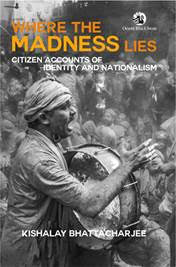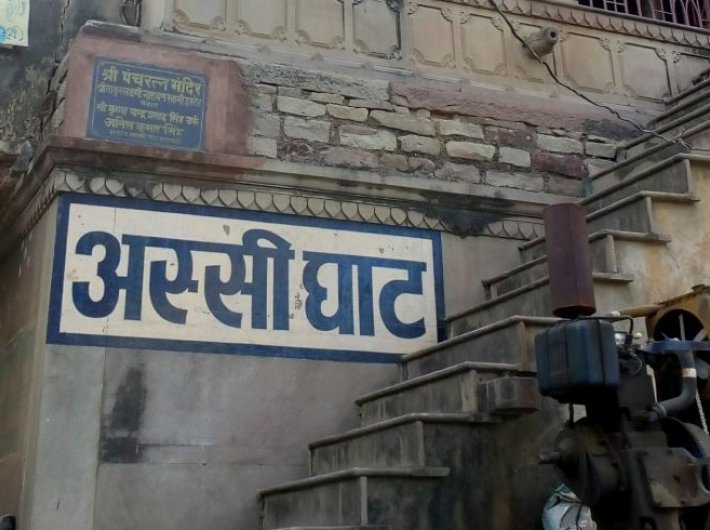Where the Madness Lies: Citizen Accounts of Identity and Nationalism
By Kishalay Bhattacharjee
Orient BlackSwan, 304 pages, Rs 950,
The idea of citizenship today conveys a static dullness, a clerical certification, and a fixed sense of identity.  By re-examining the relationship between citizenship and nationality, “Where the Madness Lies” by senior journalist Kishalay Bhattacharjee redefines the multiple sources of identity that ordinary people contend with. Citizenship becomes a critical theatre where diverse identities crisscross to create new forms of meaning and interaction.
By re-examining the relationship between citizenship and nationality, “Where the Madness Lies” by senior journalist Kishalay Bhattacharjee redefines the multiple sources of identity that ordinary people contend with. Citizenship becomes a critical theatre where diverse identities crisscross to create new forms of meaning and interaction.
Drawing from years of on-ground reportage, extensive interviews and fieldwork, the book foregrounds the perspectives of ordinary, often marginalised Indians and their everyday negotiations to carve out a place in their own country.
Bhattacharjee (who is now professor and dean, Jindal School of Journalism and Communication, and director, New Imaginations) makes poignant use of family histories, memories, experiences of migration and dislocation, and genealogies to expand upon the theme of identity. A series of compelling stories take readers from Shillong to Jalandhar, to Banaras, Guwahati, Hyderabad, and Hampi, using the voices of residents to inform us of what it means to be a citizen and ask: How does exclusion work? What does it mean to be an ‘Other’ in one’s own country?
Engaging and historically grounded, but built on multiple personal accounts, Where the Madness Lies persuades one to rethink the dominant imaginations of ‘Indianness’ and bring back a sense of plurality to the idea of an Indian. This book will offer invaluable insights to citizens, social scientists, and scholars in general to create new imaginaries of citizenship and democracy.
Here is an excerpt from the book, from a section on Banaras:
EXCERPT
Banaras
Talilla Banaras chashme baddoor
bahishte khurram-o-firadaus mamoor
(From the evil eye, may God in his greatness / save Banaras as it is a grove in paradise).
Alleys and more alleys. Cobbled alleys with sharp turns. Sacred cows, Banarasi paanwala, women with holy water, sweet-makers, loudspeakers relaying chants, rows of parked two-wheelers, overhead wires, ancient doors and windows, children in bright clothes, gatherings of the young and the old, weary travellers, pious pilgrims, the infirm and the agnostic, the policemen and the priest on duty. A city woven with ancient alleys that exhaust you, till you arrive at the Ganga, where millions have attempted to reach for salvation.
Above a flight of stairs on Panchaganga ghat rises the once-resplendent Dharhara mosque, the only mosque amongst hundreds of temples on the ghats of Banaras. It stands tall; they say that from its minars, now long gone, you could once see Dilli’s lights.
A few metres away is a Durga puja pandal full of people. It is the night of Navami, and everyone is celebrating. The drums refuse to stop.
Not very far away, loudspeakers crackle with noise and distasteful music in the name of celebration. Standing obscured by the loudspeakers and tents is a statue of the Sufi saint Kabir. This is Kabir chowk, named after the Sufi saint, and this is where he lived, although he died in Maghar, having cast aside his own city of Kashi, choosing hell over salvation. Kabir’s dissent against superstition and fanaticism led him to leave his beloved Kashi. He wrote, ‘Kaasi Maghar Sam Bichari; Ochchi Bhagat Kaisey Utras Paari—I regard both Maghar and Kashi as the same. How can you swim across with inadequate devotion (be it in Kashi or in Maghar)?’ Kabir’s sufiana is another ras of Banaras that continues to influence generations and lifestyles. But today, in the din of an overcrowded city, Kabir is difficult to locate.
Across the city, near Assi ghat, some residents have come together to discuss an impending crisis—the new political dispensation. One of the first ‘outsiders’ to make this city his own is the renegade Hindu god Shiv, who appears to light a chillum and sit down with a kulhad of chai at Pappu’s chai dukaan. It is a 100-year-old city centre of dissenting intellectuals.
To know Kashi, one must understand the mythology of Shiv. They say it is his city. That is not entirely true. Long before he descended from the mountains after his marriage to Parvati to find a place on earth, Kashi’s religious history was already being written. Historically, Shiv is not just an outsider to the Indo-Aryan pantheon, but beyond that, he contradicts Hindu customs. In mythological representations, he has no concern for purity, is not a believer of the auspicious, has no lineage, wanders naked and makes cremation grounds his home. He is casteless. Even the Vedic hymns on him are ambiguous. He is the anthropomorphic image of the city of Kashi and his baraat, with which he arrived in the city, constitutes the multicultural Banaras.
Banaras is perhaps the oldest cosmopolis made up of migrants. Eighty-four ghats garland the city where more than 50,000 Mallas dominate the population. Brahmins, Yadavs and Doms inhabit the ghats. The Yadavs made their entry only in the last 100 years, replacing Bengalis, who had made Banaras their home long before Calcutta became the capital of British India. The Bengali involvement with this city goes deep: from religion to spiritualism, from music to philosophical debates. Bengali zamindars built the city; their havelis are now falling apart in most places. The Marathas also invested in the city, but primarily for strategic interests. Mughals, Gujaratis, and the British—everyone contributed to this city, not only because of its spiritual cosmos, but also as a mercantile base. For centuries, this was one of the most important trading centres in the region.
Choudhary, popularly referred to as Dr Choudhury, a young Dom, enters the chai dukaan and joins Shiv in a corner. They are both residents of Harishchandra ghat, one of the two cremation grounds where the pyres are never doused because of the unending procession of the dead.
We are not just burning the dead, we also perform the last rites for unclaimed bodies without any payment. Every year, we perform the pind dan for them. But since the time you [Shiv] came to our shamshan ghat nothing has changed for us. Our children are not studying, because [are we to] pay school fees, or buy our daily bread? Thanks to you that Manikarnika and Harishchandra ghats have remained the heart of the city, unlike other cities, where cremation grounds are outside.
Shiv listens with indifference. He rarely speaks. Dr Choudhury continues to speak.
Ninety-nine per cent of people in our community are alcoholics because, you will know, it is impossible to carry on disposing corpses all day without being inebriated. You have been around for 3,000 years and the governments have been here 300 years, but did you or the government care to improve our situation? What about our children? Shouldn’t they get educated, compete for employment like everyone else? We earn only that much to run a family, but we don’t have enough to provide children a good education. One cremation is around 3,000 rupees. People pay lakhs of rupees to doctors, but when they come to Doms, they suddenly become poor. Are Doms the cheapest in society? We earn the least, but we are content.
Others join in the conversation. Someone new to the city observes that Banaras ghats are unique because unlike other cities, here Doms, Mallas, Brahmins and Muslims all live together on the ghats.
Dr Choudhury: Our work is divided. Doms will burn the bodies, pandits will offer the pind-dan, the Mallahs will take the ashthi and the people around. Our tradition, our parampara goes back centuries when Kalua Dom purchased Harishchandra who worked in the cremation grounds after having given his kingdom to Vishvamitra.
[The excerpt reproduced with the permission of the publishers.]
